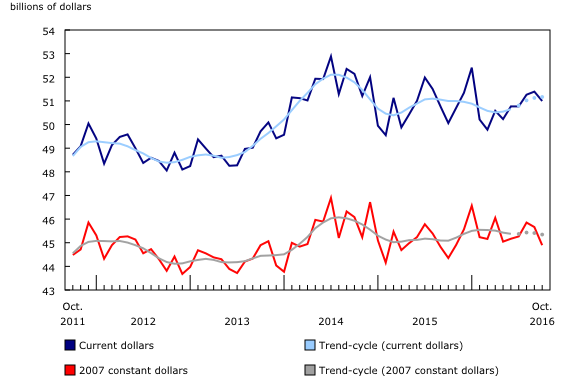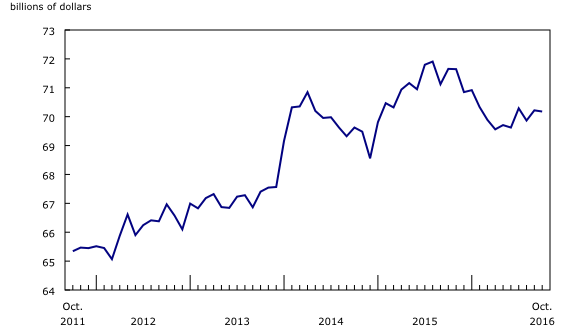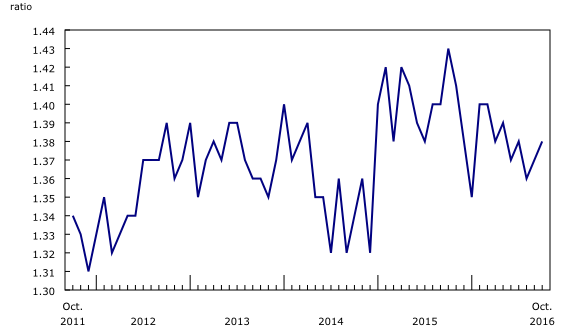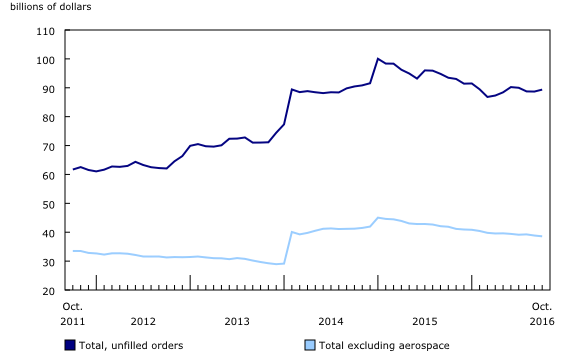Monthly Survey of Manufacturing, October 2016
Archived Content
Information identified as archived is provided for reference, research or recordkeeping purposes. It is not subject to the Government of Canada Web Standards and has not been altered or updated since it was archived. Please "contact us" to request a format other than those available.
Released: 2016-12-15
Manufacturing sales declined 0.8% to $51.0 billion in October, following two consecutive monthly gains. The largest decreases were in the primary metal, petroleum and coal product, and machinery industries.
Sales fell in 15 of 21 industries, representing 61% of the manufacturing sector. Sales of durable goods decreased 1.1%, while non-durable goods sales were down 0.4%.
Constant dollar sales declined 1.7% in October, reflecting a lower volume of manufactured goods sold. According to the Industrial Product Price Index, prices for the manufacturing sector rose 0.7% in October.
Primary metal and petroleum and coal post largest declines
Primary metal manufacturing sales were down 2.4% in October to $3.6 billion—the second consecutive monthly decline. The decrease was largely attributable to non-ferrous metal production, and iron and steel mills and ferro-alloy manufacturing.
Prices for primary non-ferrous metal products also contributed to the decrease, falling 1.9% in October, according to the Industrial Product Price Index.
Sales in the petroleum and coal product industry were down 1.7% in October to $4.3 billion, the second consecutive monthly decline. The decrease in October was entirely attributable to lower volumes of product sold, as prices for the industry rose 4.8% according to the Industrial Product Price Index. Maintenance and turnaround work at some facilities also lowered production.
Lower sales in the railroad rolling stock (-31.2%), machinery (-2.5%), food (-0.7%) and fabricated metal product (-2.3%) industries also contributed to the overall decrease in October.
These declines were partially offset by a 5.3% increase in the aerospace product and parts industry, partly reflecting changes in the value of the US dollar relative to the Canadian dollar. Sales and inventories in the aerospace industry are mainly reported in US dollars.
Sales of other transportation equipment (+21.6%), chemicals (+1.2%), paper (+1.0%) and clothing (+10.6%) also rose in October.
Sales down in seven provinces
Sales were down in seven provinces in October, with Ontario, Quebec and Alberta posting the largest declines.
Sales in Ontario were down 0.8% to $25.0 billion, following two consecutive monthly gains. The decline in October reflected lower sales in the transportation equipment (-0.7%), machinery (-4.2%) and beverage and tobacco (-6.9%) industries.
In Quebec, sales decreased 1.2% to $11.7 billion in October, following a 1.5% increase in September. Manufacturers of petroleum and coal products, primary metals and food products reported the largest declines.
Manufacturing sales in Alberta fell 2.0% to $5.2 billion in October, mainly the result of lower sales in the petroleum and coal product (-6.2%) and the fabricated metal product (-8.9%) industries.
The overall decline in October was partially offset by higher sales in Newfoundland and Labrador (+18.9%) and Manitoba (+2.1%). For both provinces, higher non-durable goods sales were largely responsible for the gains.
Inventories edge down
Inventory levels edged down 0.1% in October to $70.2 billion. Inventories were down in 12 of 21 industries, led by the aerospace product and parts (-4.2%) and wood product (-3.4%) industries. A 7.6% increase in petroleum and coal product inventories partly offset the declines.
The inventory-to-sales ratio rose from 1.37 in September to 1.38 in October. The inventory-to-sales ratio measures the time, in months, that would be required to exhaust inventories if sales were to remain at their current level.
Unfilled orders rise
Unfilled orders rose 0.8% to $89.4 billion in October, following three months of declines. The increase was attributable to higher unfilled orders in the transportation equipment, computer and electronic product, and primary metal industries.
New orders rose for the second consecutive month, up 0.7% to $51.7 billion in October as a result of gains in the aerospace product and parts and computer and electronic industries. The increase was partially offset by lower new orders in machinery and food industries.
Note to readers
Monthly data in this release are seasonally adjusted and are expressed in current dollars unless otherwise specified. For information on seasonal adjustment, see Seasonally adjusted data – Frequently asked questions.
For information on trend-cycle data, see Trend-cycle estimates – Frequently asked questions.
Non-durable goods industries include food, beverage and tobacco products, textile mills, textile product mills, clothing, leather and allied products, paper, printing and related support activities, petroleum and coal products, chemicals, and plastics and rubber products.
Durable goods industries include wood products, non-metallic mineral products, primary metals, fabricated metal products, machinery, computer and electronic products, electrical equipment, appliances and components, transportation equipment, furniture and related products, and miscellaneous manufacturing.
Production-based industries
For the aerospace and shipbuilding industries, the value of production is used instead of the value of sales of goods manufactured. The value of production is calculated by adjusting monthly sales of goods manufactured by the monthly change in inventories of goods in process and finished products manufactured. The value of production is used because of the extended period of time that it normally takes to manufacture products in these industries.
Unfilled orders are a stock of orders that will contribute to future sales assuming that the orders are not cancelled.
New orders are those received, whether sold in the current month or not. New orders are measured as the sum of sales for the current month plus the change in unfilled orders from the previous month to the current month.
Manufacturers reporting in US dollars
Some Canadian manufacturers report sales, inventories and unfilled orders in US dollars. These data are then converted to Canadian dollars as part of the data production cycle.
For sales, based on the assumption that they occur throughout the month, the average monthly exchange rate for the reference month (noon spot rate) established by the Bank of Canada is used for the conversion. The monthly average exchange rate is available in CANSIM table 176-0064.
Inventories and unfilled orders are reported at the end of the reference period. For most respondents, the noon spot exchange rate on the last working day of the month is used for the conversion of these variables. However, some manufacturers choose to report their data as of a day other than the last day of the month. In these instances, the noon spot exchange rate on the day selected by the respondent is used. Note that because of exchange rate fluctuations, the noon spot exchange rate on the day selected by the respondent can differ from both the exchange rate on the last working day of the month and the monthly average exchange rate. Noon spot exchange rate data are available in CANSIM table 176-0067.
Revision policy
Each month, the Monthly Survey of Manufacturing releases preliminary data for the reference month and revised data for the three previous months. Revisions are made to reflect new information provided by respondents and updates to administrative data. Once a year, a revision project is undertaken to revise multiple years of data. During annual revisions, changes are made to seasonal adjustment parameters.
Real-time CANSIM tables
Real-time CANSIM tables 304-8014, 304-8015 and 377-8009 will be updated on January 4, 2017. For more information, consult the document Real-time CANSIM tables.
Next release
Data from the Monthly Survey of Manufacturing for November 2016 will be released on January 19, 2017.
Contact information
For more information, contact us (toll-free 1-800-263-1136; 514-283-8300; STATCAN.infostats-infostats.STATCAN@canada.ca).
To enquire about the concepts, methods or data quality of this release, contact Bechir Oueriemmi (613-951-7938; bechir.oueriemmi@canada.ca) or Michael Schimpf (613-863-4480; michael.schimpf@canada.ca), Manufacturing and Wholesale Trade Division.
- Date modified:







